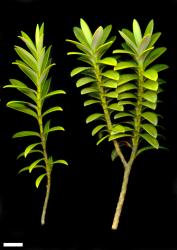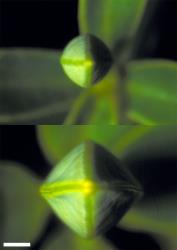- ≡ Hebe rigidula (Cheeseman) Cockayne & Allan, Trans. New Zealand Inst. 56: 20 (1926)
Low, open-branched shrub to 0.6 m tall. Stems ascending to erect, eglandular-pubescent; hairs bifarious. Leaf bud distinct, its leaves appressed at margins until fully grown; sinus acute. Leaves opposite-decussate, erecto-patent to spreading; lamina sub-coriaceous to coriaceous, lanceolate to narrowly or broadly elliptic to oblong to oblanceolate, 7–25 mm long, 2–9 mm wide, dull to slightly glossy green or yellowish-green above, dull glaucous to glaucescent beneath; midrib evident; surfaces glabrous or sometimes eglandular hairs along midrib above; margin glabrous, minutely papillate, entire; apex sub-acute to acute, acuminate to weakly plicate-acuminate; base cuneate; petiole 2.0–3.2 mm long. Inflorescence a lateral, usually tripartite, but sometimes simple or compound, raceme, 14–32 mm long; flowers crowded, 10–40, all bisexual; bracts opposite-decussate, sometimes becoming alternate above, ovate to deltoid, > pedicels; pedicels erecto-patent, 0.1–2.0 mm long, eglandular-hairy all around, or rarely absent. Calyx lobes 4, sub-acute to obtuse, 1.5–2.6 mm long, sub-equal, eglandular-ciliate or mixed glandular- and eglandular-ciliate. Corolla 5–7 mm diameter; tube white, 2.5–5.0 mm long, > calyx, glabrous; lobes 4, white, erecto-patent to spreading, becoming recurved, sub-equal, elliptic to ovate or rhomboid, 2–3 mm long, obtuse or sometimes posterior emarginate; nectar guides absent. Stamen filaments white, 3–4 mm long; anthers buff to pink. Style glabrous, 5–7 mm long. Capsules latiseptate, sub-acute to obtuse, glabrous, 2.4–4.0 mm long, 1.8–2.5 mm at widest point. Seeds ellipsoid to discoid or irregular, flattened, smooth, pale brown to brown, 0.8–1.6 mm long.
| 1 | Lamina concave when viewed from above, usually narrowly elliptic or sometimes elliptic or oblanceolate, mostly 3.6–4.4 times as long as broad; pedicels 0.1–0.8 mm long | var. rigidula |
| Lamina longitudinally folded and each half convex when viewed from above, elliptic to broadly elliptic, mostly 2.8–3.3 times as long as broad; pedicels 0.3–2.0 mm long | var. sulcata |
Veronica rigidula is one of a few species characterised by discolorous leaves and usually tripartite inflorescences. V. rupicola plants are similar but differ in brighter green leaves, large bracts that almost completely obscure the larger calyx, sessile or sub-sessile flowers, and acuminate corolla lobes; its distribution is in eastern Marlborough. Plants of V. scopulorum, which grow near Raglan in the North Island, are also similar, and differ in the strongly tetragonous leaf buds with concave faces, and generally longer leaves and pedicels.
V. rigidula specimens have been confused in collections with V. subfulvid. V. subfulvida plants are similar because they also have a sinus, compound racemes and somewhat discolorous leaves, but they differ in their larger stature, leaves never glaucous (green to dark green above, paler beneath), and hairs inside the corolla tube.
South Island: Sounds Nelson.
Open rocky habitats, sparse scrub, outcrops, boulder falls, cliffs, and gorges. Recorded elevations range from 21 to 1524 m.
| Category | Number |
|---|---|
| Indigenous (Endemic) | 2 |
| Total | 2 |
Flowers: November–February; fruits: December–March (persisting until October).
2n = 40 (see Bayly & Kellow 2006, as Hebe rigidula var. rigidula and var. sulcata).
Veronica rigidula is classified in V. subg. Pseudoveronica sect. Hebe and the informal group “Apertae” (small-leaved) (Albach & Meudt 2010; Bayly & Kellow 2006). The phylogenetic position of Veronica rigidula is unclear. Similar species among the many that appear to be related to it on the basis of ITS sequence data (E.M. Low, unpublished) include V. rupicola and V. subfulvida.





